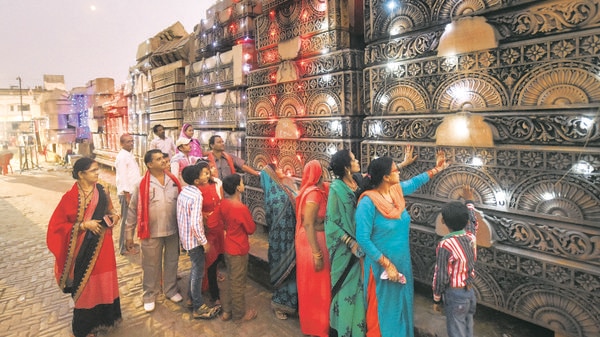Ayodhya: Wearing a yellow kurta with ‘Jai Shri Ram’ prints and sporting a prominent ‘tilak’ on his forehead, teenager Shivam Kumar travelled all the way from Bihar’s Rohtas district to here, carrying a sack full of bricks to deposit at a Ram temple workshop in the holy town. The November 9, Supreme Court verdict on the Ayodhya dispute was a moment of unbridled joy for the Ram devotee.
“I was just too anxious to come to Ayodhya, and so I, along with two other friends, decided to head to ‘Ram ki Nagari’ and contribute my bit for the temple,” said Kumar.
Kumar, 16, joined lakhs of people in this holy town who had converged here for ‘Kartik Purnima’ holy dip Tuesday. A native of Dehri-on-Sone town in Rohtas, he is pursuing his graduation in science stream.
“This is my first visit to Ayodhya. I had never thought that I will be coming here so soon,” Kumar said, as he carefully laid out red bricks on old stacks of the same material brought by devotees over the years to the sprawling premises of a Ram temple workshop being run by ‘Ramjanmabhoomi Nyas since’ 1990 at Karsewakpuram.
Viswa Hindu Parishad (VHP) spokesperson Sharad Sharma said the number of devotees visiting the workshop has spiked since the Supreme Court judgement on November 9.
“Saturday night, a lot of people visited the workshop and the number has only multiplied over the next few days. Normally, about 1,000 people visit the workshop every day. The number has now risen to nearly 5,000. The Karsewakpuram workshop has become a big tourist attraction,” Sharma said.
From far-off Gujarat to neighbouring cities in Uttar Pradesh, the list of first-timers visiting the site is increasing.
KP Yadav, 20, who came from Moradabad, was seen taking selfies against the backdrop of the ‘Ramshila’ wall put up by the VHP from the bricks which earlier had been laid near the Ramjanmabhoomi site, donated by Indians at home and abroad.
From Pratapgarh, Gaurav Uma Vaish, 16, and Janhvi Uma Vaish, 14, visited Ayodhya for the first time, accompanied by their parents. They were both wearing marigold garlands after visiting the Hanuman Garhi temple.
Rakesh Kumar, their father, said the family visited Ayodhya for the Kartik Purnima holy dip but the visit became ‘all the more special’ as the Supreme Court has ruled in favour of the construction of a temple for Ram Lallah.
Most devotees first pay obeisance at Ramjanmabhoomi and then visit Karsewakpuram to see the temple model and carved stones. Many who had earlier vidited Ayodhya but not Karsewakpuram also made a beeline for the workshop.
Lucknow resident Anjali Singh, 26, who works in a private company, was thrilled to be in Ayodhya for the first time. She was accompanied by her mother, a regular visitor. The duo went to well-known places like Hanuman Garhi temple, Kanak Bhawan, besides taking a holy dip in Saryu and attending the evening ‘aarti’.
“The city definitely has more to it than what is usually portrayed through the media. I am delighted to see this ‘Ram ki Nagari’ but I am also aware of the tragic past this city is trying to put behind after what happened in 1992, even though I was not born then. Ayodhya now must not let its social fabric be torn again,” asserted Anjali.
Since 1990 artisans and craftsmen have fashioned out magnificently carved stones and pillars, with the assumption that one day they will be used to build a temple for Ram Lallah.
As per the Nyas’s plan, the temple, once built, will be 268 ft long, 140 ft wide and 128 ft high, from the ground to the apex point (Shikhar) and a total of 212 pillars will be used, according to 79-year-old Annu Bhai Sompura, in-charge of the workshop.
PTI
